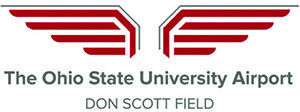What began as a 1942 military training facility and group of outdated buildings is now a modern general aviation terminal, fixed base operator and flight school all in one building. In August, Ohio State University Airport/Don Scott Field (OSU) opened its new $15 million Austin E. Knowlton Executive Terminal and Aviation Learning Center.
 The airport, located just 11 miles northwest of downtown Columbus, owns/operates the fixed base operator and runs the university flight training program, which is also open to the public. Airport Director Doug Hammon explains that OSU Airport’s main mission is to support the university’s teaching, research and outreach activities, but it also functions as a traditional airport. In fact, it’s the third busiest in Ohio. “We try to balance those things and think we do it pretty well,” Hammon remarks.
The airport, located just 11 miles northwest of downtown Columbus, owns/operates the fixed base operator and runs the university flight training program, which is also open to the public. Airport Director Doug Hammon explains that OSU Airport’s main mission is to support the university’s teaching, research and outreach activities, but it also functions as a traditional airport. In fact, it’s the third busiest in Ohio. “We try to balance those things and think we do it pretty well,” Hammon remarks.
The airport became public in the late 1950s and ’60s, after receiving federal funds for runway improvements. From there, it has grown into a tier one university research support center and one of the state’s leading corporate airports, says Hammon.
“Through this project, we’ve been able to not only have modern amenities for the airport, but also have a facility to provide aviation students a greater insight into the industry and world,” he adds.
|
Project: New Terminal Location: Ohio State University Airport/Don Scott Field Primary Components: Administration Offices; Fixed Base Operator; Flight School Size: 2 stories; 29,500 sq. ft. Cost: $15 million
Funding: $10 million from Knowlton Foundation;
Project Timeline: Design process began in Architect: Moody Nolan Inc. General Contractor: Whiting-Turner Inc. Notable Features: More overall space; larger, upgraded teaching areas; new observation deck; Buckeye décor; improved amenities such as Wi-Fi coverage, charging stations & 19 televisions Proposed Future Projects: 1,000-ft. runway extension; corporate air park; self-fueling station; aerospace & aviation academic/research laboratory |
Then & Now
Consolidating OSU’s three separate, aging buildings into one modern facility has been a welcome transformation for airport customers and staff. “The terminal was built in 1942 and trying to operate successfully in 2017,” Hammon explains. “The flight school was an old office that was never designed for a flight school; it was too small. The administration building was old and didn’t provide teaching facilities to help students or an attractive entryway to central Ohio.”
Today, all these boxes have been checked. “The airport offers a grand entrance, and there’s so much space now,” says Mike Eppley, general manager of the airport’s fixed base operator (FBO). “We were in a 1940s building, and now it’s a 2018 building. There’s just something about it that is a hundred times better!”
Five years ago, airport officials began serious conversations with the Knowlton Foundation. Its benefactor, the late Austin E. Knowlton, was an aviation enthusiast and had expressed a desire to provide funding for OSU Airport.
The foundation consequently provided the $10 million needed to move the facility project forward, and the remaining $5 million is being generated through contributions from other donors and revenue from 54 new T hangars. Revenue was available shortly after construction, as the hangars were promptly filled by a waiting list of more than 130 aircraft operators wanting space at the airport.
One of the foundation’s specific goals for the new terminal facility was to include a space for pilots and students to interact. “You know pilots love to talk, and students do, too,” Hammon muses. “If they can get together and simply share stories, then students can understand what the life of a pilot is like before they get out there. That was the foundation’s vision and what brought us all together in one facility.”
The design process began in 2015 and took about two years. Construction started in fall 2017, and the new terminal and training center opened this August. Minor cosmetic touches and final clean up are still underway.
Core Curriculum
A university airport is a unique business. It has an educational component but must also function efficiently for other users. During the initial design stages for the new terminal at OSU Airport, it was imperative for the airport team to educate university officials in charge of construction projects about the inner workings of an FBO/flight school and their operational needs, such as longer runways.
“We had to help them understand our industry and what needed to be included in those structures so we could be the best business possible,” Hammon explains.
The new FBO/training building is two stories tall, with large glass windows overlooking the airfield. In the first week alone, dozens from the surrounding community came to see the airfield from the new observation deck. “We really built this space to be interactive with the community,” Hammon says, noting that a public open house is being planned for early 2019. To help fulfill that outreach mission, the airport opens its doors to more than 2,500 youth each year.

While some visitors miss the old terminal’s 360-degree view, Eppley reports that the new views and other facility upgrades have been well received by customers, community members and staff.
Some customers fly into the facility simply to use the airport’s meeting space for local appointments or conferences that involve attendees from various locations. Three classrooms on the second floor can accommodate 50 people each, or the spaces can be combined to create one more expansive room for conferences and other large events.
Hammon suspects that the airport’s calendar is already filling up with reservations for the rental space because it boasts such a nice, full view of the airfield. As word spreads about the facility and passengers see it as they arrive and depart the airport, the team expects demand will continue to grow. University alumni are already enthusiastic about the Buckeye theme throughout the facility, and usage is anticipated to be especially high during this and future college football seasons.
 “Normally, we book one bus per weekend to take people to the game,” says Eppley. “Just knowing how this place will attract people, I’ve already booked two. A lot of alumni have flown in for years and will really be looking forward to coming through the new terminal.”
“Normally, we book one bus per weekend to take people to the game,” says Eppley. “Just knowing how this place will attract people, I’ve already booked two. A lot of alumni have flown in for years and will really be looking forward to coming through the new terminal.”
Improved Wi-Fi coverage, USB charging stations throughout the new building and 19 televisions (vs. just one previously) promise to be particularly popular amenities. “New carpeting and flooring are pretty good, too,” jokes Hammon.
Training the Next Generation
“As we all know, we have a pilot shortage,” says Brandon Mann, the university’s director of flight education. “We have now seen our enrollment numbers increase dramatically to 115 students—the highest we’ve seen in nearly 20 years.”
Mann credits the recent surge of interest in the flight program to the new building, which has more space, improved teaching areas and updated technology, including a new dispatch system. Private testing rooms were added to help students concentrate, and flight instructors no longer battle to reserve space, because there are now three classrooms rather than one.
 Designers improved the entrance to the flight education terminal and added glass walls to provide a direct view into the simulator labs. Overall, the added space and modern upgrades have been a tremendous benefit for students and teaching staff, notes Mann.
Designers improved the entrance to the flight education terminal and added glass walls to provide a direct view into the simulator labs. Overall, the added space and modern upgrades have been a tremendous benefit for students and teaching staff, notes Mann.
By design, OSU’s training program and new facility offer ample opportunities for interaction between students and professional pilots, especially corporate pilots. The goal is to increase enrollment to 200 students in the next five years and phase out older aircraft with seven Cessna Skyhawk 172 trainers donated by NetJets.
“They are G1000 full auto-pilot aircraft, so our students are getting state-of-the-art technology to learn with,” says Mann. NetJets has been a strong partner with OSU for a long time, and the donated aircraft are the latest of many contributions to improve student learning and expose them to advanced aviation technology.
Non-aviation departments from the university also use the airport for course work such as city planning engineering and drone activity. Other nearby universities use the facility, too. All students from all departments and schools can register for flight training to earn a pilot’s license.
Of about 100 airport employees, 30 to 35 are students. “Talk about hands-on experience!” says Hammon. “On the weekends or evenings, you’ll probably see more student employees than full-time staff.”
Next Steps
Currently, the OSU Airport team is in the process of a master plan update—the first since 1990, when the university decided to keep the airport. The facility’s importance for research and outreach was more fully realized, and the time came to move forward with the next steps, Hammon explains. The team’s goal is to send the master plan up the chain to the FAA in early 2019.
The next major initiative in the current master plan is a 50-acre corporate air park. Discussions are in the works whether to develop infrastructure for leased and/or occupant-built structures, or to let an outside company develop and lease all 50 acres. Decisions will likely be made within the next half-year.
The second master plan project is a much-needed runway extension. “This has been in the books since the ’80s,” Hammon remarks. “We have 5,000 feet, but we really need 6,000 so the airport can physically fit the level of planes our corporate customers use.” Several corporate clients would like to be able to make trans-Atlantic trips without stopping at the coast to refuel.
Safety is the other main impetus for the runway extension project. “It’s kind of dicey in winter on the 5,000 feet,” Hammon explains. “That extra thousand feet for landing would be good to help stop on ice; or, on a hot summer day, to be able to get out better.”
Extra runway length would also help with noise issues, as aircraft won’t need as much power to climb out. The airport is now surrounded by a suburban area, but that wasn’t the case 75 years ago when it was built. “When someone hears the term ‘runway extension,’ the first thing they will think is bigger, louder planes,” he says. “That’s not the case. The longer runway will actually allow aircraft to operate more efficiently. We want to help improve the noise situation for neighborhoods around the airport.”
If approved and funded, the runway extension and corporate park will complement the new Austin E. Knowlton Executive Terminal and Aviation Learning Center, which is already making its mark serving the university and surrounding community.


 facts&figures
facts&figures

